2004 CHEVROLET CLASSIC steering wheel
[x] Cancel search: steering wheelPage 190 of 348
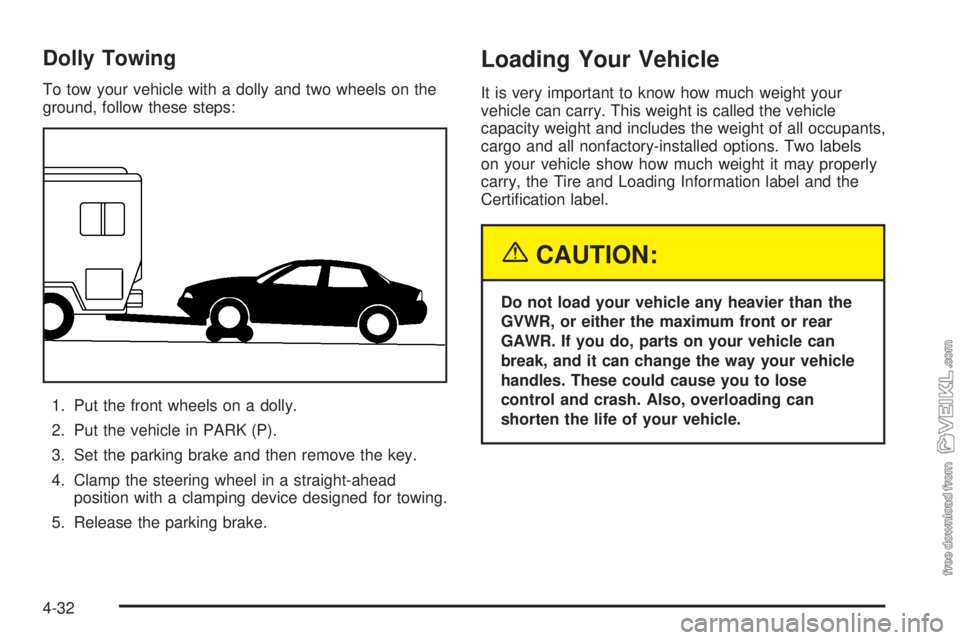
Dolly Towing
To tow your vehicle with a dolly and two wheels on the
ground, follow these steps:
1. Put the front wheels on a dolly.
2. Put the vehicle in PARK (P).
3. Set the parking brake and then remove the key.
4. Clamp the steering wheel in a straight-ahead
position with a clamping device designed for towing.
5. Release the parking brake.
Loading Your Vehicle
It is very important to know how much weight your
vehicle can carry. This weight is called the vehicle
capacity weight and includes the weight of all occupants,
cargo and all nonfactory-installed options. Two labels
on your vehicle show how much weight it may properly
carry, the Tire and Loading Information label and the
Certification label.
{CAUTION:
Do not load your vehicle any heavier than the
GVWR, or either the maximum front or rear
GAWR. If you do, parts on your vehicle can
break, and it can change the way your vehicle
handles. These could cause you to lose
control and crash. Also, overloading can
shorten the life of your vehicle.
4-32
Page 200 of 348
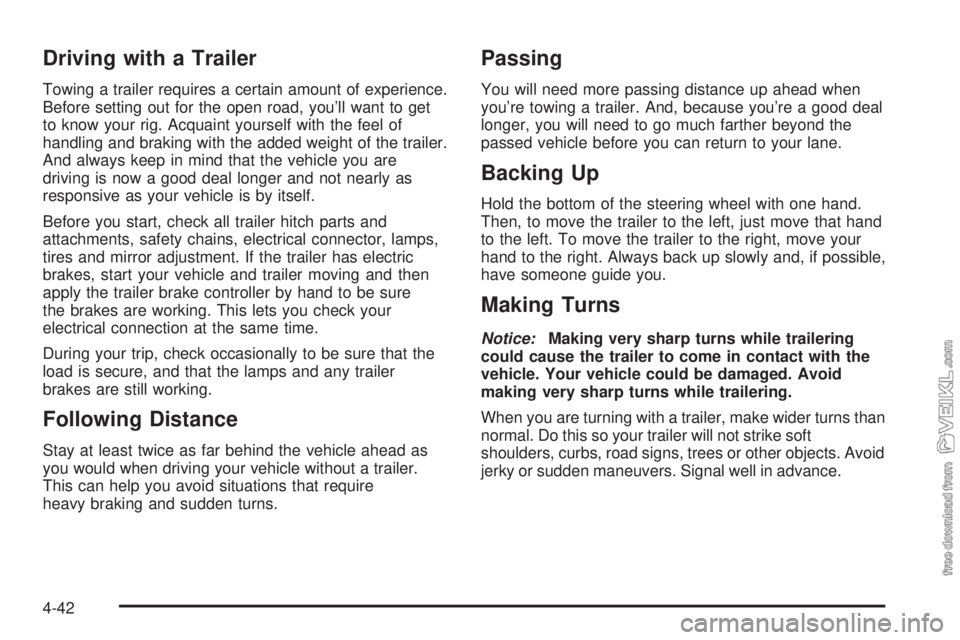
Driving with a Trailer
Towing a trailer requires a certain amount of experience.
Before setting out for the open road, you’ll want to get
to know your rig. Acquaint yourself with the feel of
handling and braking with the added weight of the trailer.
And always keep in mind that the vehicle you are
driving is now a good deal longer and not nearly as
responsive as your vehicle is by itself.
Before you start, check all trailer hitch parts and
attachments, safety chains, electrical connector, lamps,
tires and mirror adjustment. If the trailer has electric
brakes, start your vehicle and trailer moving and then
apply the trailer brake controller by hand to be sure
the brakes are working. This lets you check your
electrical connection at the same time.
During your trip, check occasionally to be sure that the
load is secure, and that the lamps and any trailer
brakes are still working.
Following Distance
Stay at least twice as far behind the vehicle ahead as
you would when driving your vehicle without a trailer.
This can help you avoid situations that require
heavy braking and sudden turns.
Passing
You will need more passing distance up ahead when
you’re towing a trailer. And, because you’re a good deal
longer, you will need to go much farther beyond the
passed vehicle before you can return to your lane.
Backing Up
Hold the bottom of the steering wheel with one hand.
Then, to move the trailer to the left, just move that hand
to the left. To move the trailer to the right, move your
hand to the right. Always back up slowly and, if possible,
have someone guide you.
Making Turns
Notice:Making very sharp turns while trailering
could cause the trailer to come in contact with the
vehicle. Your vehicle could be damaged. Avoid
making very sharp turns while trailering.
When you are turning with a trailer, make wider turns than
normal. Do this so your trailer will not strike soft
shoulders, curbs, road signs, trees or other objects. Avoid
jerky or sudden maneuvers. Signal well in advance.
4-42
Page 203 of 348
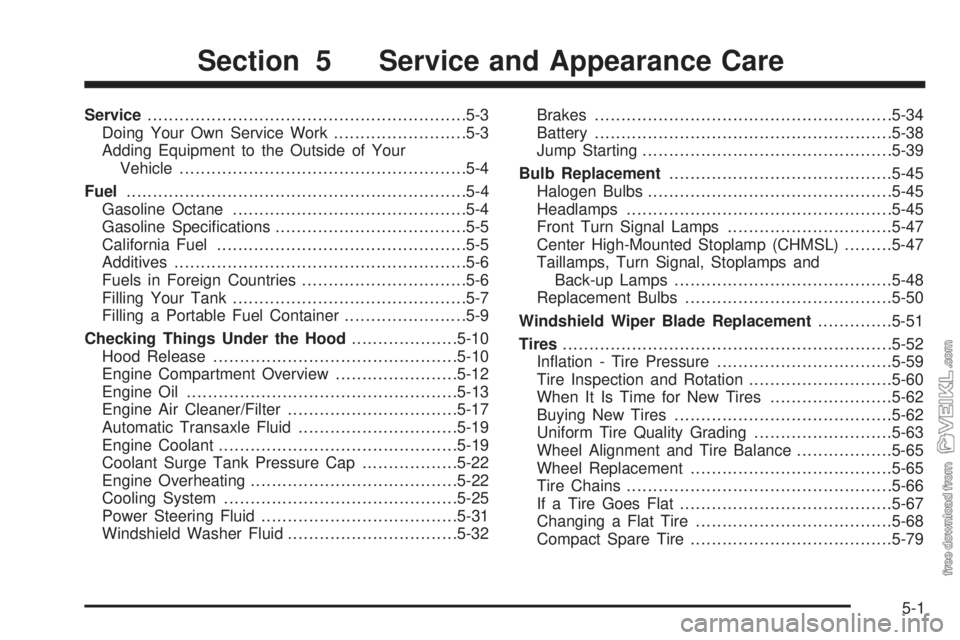
Service............................................................5-3
Doing Your Own Service Work.........................5-3
Adding Equipment to the Outside of Your
Vehicle......................................................5-4
Fuel................................................................5-4
Gasoline Octane............................................5-4
Gasoline Specifications....................................5-5
California Fuel...............................................5-5
Additives.......................................................5-6
Fuels in Foreign Countries...............................5-6
Filling Your Tank............................................5-7
Filling a Portable Fuel Container.......................5-9
Checking Things Under the Hood....................5-10
Hood Release..............................................5-10
Engine Compartment Overview.......................5-12
Engine Oil...................................................5-13
Engine Air Cleaner/Filter................................5-17
Automatic Transaxle Fluid..............................5-19
Engine Coolant.............................................5-19
Coolant Surge Tank Pressure Cap..................5-22
Engine Overheating.......................................5-22
Cooling System............................................5-25
Power Steering Fluid.....................................5-31
Windshield Washer Fluid................................5-32Brakes........................................................5-34
Battery........................................................5-38
Jump Starting...............................................5-39
Bulb Replacement..........................................5-45
Halogen Bulbs..............................................5-45
Headlamps..................................................5-45
Front Turn Signal Lamps...............................5-47
Center High-Mounted Stoplamp (CHMSL).........5-47
Taillamps, Turn Signal, Stoplamps and
Back-up Lamps.........................................5-48
Replacement Bulbs.......................................5-50
Windshield Wiper Blade Replacement..............5-51
Tires..............................................................5-52
Inflation - Tire Pressure.................................5-59
Tire Inspection and Rotation...........................5-60
When It Is Time for New Tires.......................5-62
Buying New Tires.........................................5-62
Uniform Tire Quality Grading..........................5-63
Wheel Alignment and Tire Balance..................5-65
Wheel Replacement......................................5-65
Tire Chains..................................................5-66
If a Tire Goes Flat........................................5-67
Changing a Flat Tire.....................................5-68
Compact Spare Tire......................................5-79
Section 5 Service and Appearance Care
5-1
Page 269 of 348
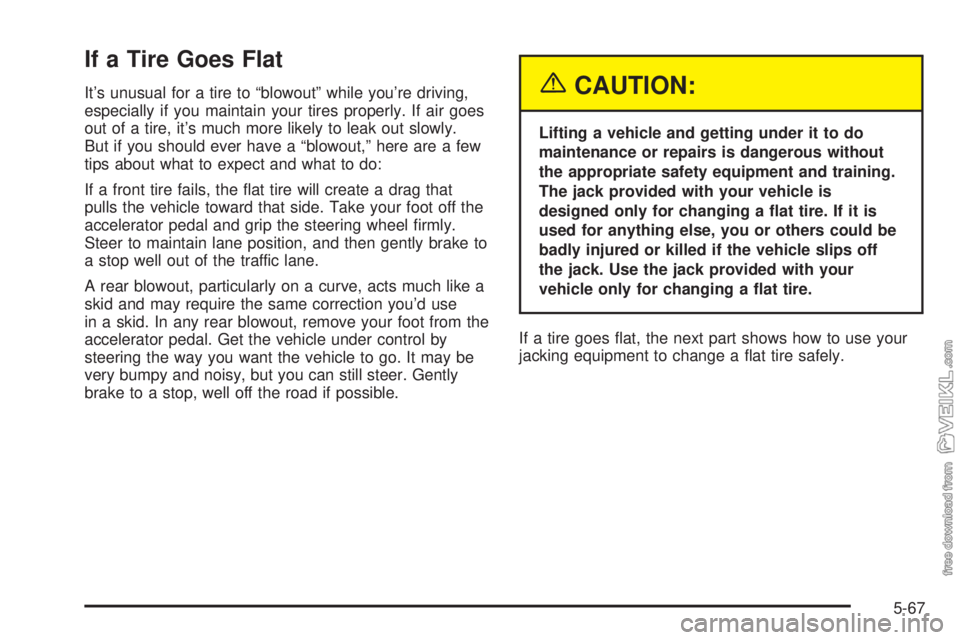
If a Tire Goes Flat
It’s unusual for a tire to “blowout” while you’re driving,
especially if you maintain your tires properly. If air goes
out of a tire, it’s much more likely to leak out slowly.
But if you should ever have a “blowout,” here are a few
tips about what to expect and what to do:
If a front tire fails, the flat tire will create a drag that
pulls the vehicle toward that side. Take your foot off the
accelerator pedal and grip the steering wheel firmly.
Steer to maintain lane position, and then gently brake to
a stop well out of the traffic lane.
A rear blowout, particularly on a curve, acts much like a
skid and may require the same correction you’d use
in a skid. In any rear blowout, remove your foot from the
accelerator pedal. Get the vehicle under control by
steering the way you want the vehicle to go. It may be
very bumpy and noisy, but you can still steer. Gently
brake to a stop, well off the road if possible.{CAUTION:
Lifting a vehicle and getting under it to do
maintenance or repairs is dangerous without
the appropriate safety equipment and training.
The jack provided with your vehicle is
designed only for changing a �at tire. If it is
used for anything else, you or others could be
badly injured or killed if the vehicle slips off
the jack. Use the jack provided with your
vehicle only for changing a �at tire.
If a tire goes flat, the next part shows how to use your
jacking equipment to change a flat tire safely.
5-67
Page 346 of 348
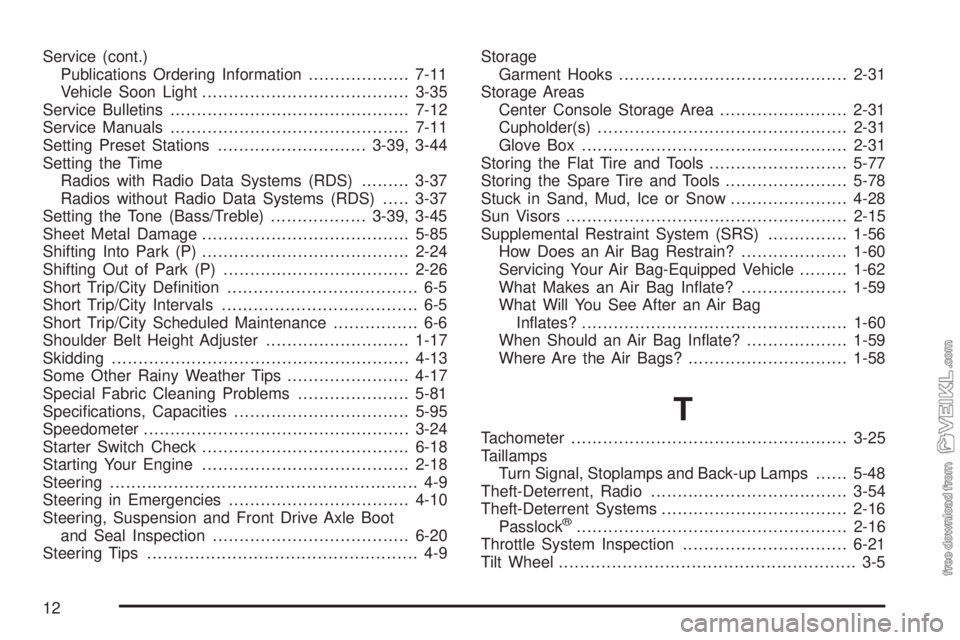
Service (cont.)
Publications Ordering Information...................7-11
Vehicle Soon Light.......................................3-35
Service Bulletins.............................................7-12
Service Manuals.............................................7-11
Setting Preset Stations............................3-39, 3-44
Setting the Time
Radios with Radio Data Systems (RDS).........3-37
Radios without Radio Data Systems (RDS).....3-37
Setting the Tone (Bass/Treble)..................3-39, 3-45
Sheet Metal Damage.......................................5-85
Shifting Into Park (P).......................................2-24
Shifting Out of Park (P)...................................2-26
Short Trip/City Definition.................................... 6-5
Short Trip/City Intervals..................................... 6-5
Short Trip/City Scheduled Maintenance................ 6-6
Shoulder Belt Height Adjuster...........................1-17
Skidding........................................................4-13
Some Other Rainy Weather Tips.......................4-17
Special Fabric Cleaning Problems.....................5-81
Specifications, Capacities.................................5-95
Speedometer..................................................3-24
Starter Switch Check.......................................6-18
Starting Your Engine.......................................2-18
Steering.......................................................... 4-9
Steering in Emergencies..................................4-10
Steering, Suspension and Front Drive Axle Boot
and Seal Inspection.....................................6-20
Steering Tips................................................... 4-9Storage
Garment Hooks...........................................2-31
Storage Areas
Center Console Storage Area........................2-31
Cupholder(s)...............................................2-31
Glove Box..................................................2-31
Storing the Flat Tire and Tools..........................5-77
Storing the Spare Tire and Tools.......................5-78
Stuck in Sand, Mud, Ice or Snow......................4-28
Sun Visors.....................................................2-15
Supplemental Restraint System (SRS)...............1-56
How Does an Air Bag Restrain?....................1-60
Servicing Your Air Bag-Equipped Vehicle.........1-62
What Makes an Air Bag Inflate?....................1-59
What Will You See After an Air Bag
Inflates?..................................................1-60
When Should an Air Bag Inflate?...................1-59
Where Are the Air Bags?..............................1-58
T
Tachometer....................................................3-25
Taillamps
Turn Signal, Stoplamps and Back-up Lamps......5-48
Theft-Deterrent, Radio.....................................3-54
Theft-Deterrent Systems...................................2-16
Passlock
®...................................................2-16
Throttle System Inspection...............................6-21
Tilt Wheel........................................................ 3-5
12
Page 348 of 348

Vehicle Data Collection and Event Data
Records.....................................................7-10
Vehicle Identification
Number (VIN).............................................5-88
Service Parts Identification Label...................5-88
Vehicle Storage..............................................5-38
Ventilation Adjustment......................................3-21
Visors...........................................................2-15
W
Warning Lights, Gages and Indicators................3-22
Warnings
Hazard Warning Flashers............................... 3-4
Other Warning Devices.................................. 3-5
Safety and Symbols......................................... iii
Vehicle Damage.............................................. iv
Washer Fluid, Low Warning Light......................3-34
Washing Your Vehicle......................................5-83
Weatherstrip Lubrication...................................6-17
Weight of the Trailer........................................4-39
Weight of the Trailer Tongue.............................4-40
What Kind of Engine Oil to Use........................5-14
What to Do with Used Oil................................5-16
What to Use..........................................5-20, 5-32
Wheels
Alignment and Tire Balance..........................5-65
Replacement...............................................5-65When to Add Engine Oil..................................5-14
When to Change Engine Oil.............................5-16
When to Check..............................................5-60
When to Check Power Steering Fluid................5-32
When to Inspect the Engine Air Cleaner/Filter.....5-17
When You Are Ready to Leave After Parking
on a Hill.....................................................4-44
Where to Put the Restraint...............................1-42
Why Safety Belts Work..................................... 1-9
Window Lockout.............................................2-15
Windows.......................................................2-14
Power........................................................2-15
Windshield Washer........................................... 3-9
Fluid..........................................................5-32
Windshield Washer Fluid Level Check................6-16
Windshield Wiper
Blade Replacement......................................5-51
Fuses........................................................5-89
Windshield Wiper Lever..................................... 3-8
Winter Driving................................................4-23
Wiper Blade Check.........................................6-17
Y
Your Vehicle and the Environment....................... 6-2
14